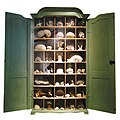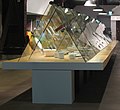Portal:Museums
The Museums Portal
A museum (/mjuːˈziːəm/ mew-ZEE-əm) is an institution dedicated to displaying and/or preserving culturally or scientifically significant objects. Many museums have exhibitions of these objects on public display, and some have private collections that are used by researchers and specialists. Compared to a library, a museum hosts a much wider range of objects and usually focus around a specific theme such as the arts, science, natural history, local history, and other topics. Public museums that host exhibitions and interactive demonstrations are often considered to be tourist attractions, and many museums attract large numbers of visitors from outside their host country, with the most visited museums in the world regularly attracting millions of visitors annually.
Since the establishment of the earliest known museum in ancient times, museums have been associated with academia and the preservation of rare items. Museums originated as private collections of interesting items, and not until much later did the emphasis on educating the public take root. (Full article...)
Selected museum
The Great Library of Alexandria in Alexandria, Egypt, was one of the largest and most significant libraries of the ancient world. The library was part of a larger research institution called the Mouseion, which was dedicated to the Muses, the nine goddesses of the arts. The idea of a universal library in Alexandria may have been proposed by Demetrius of Phalerum, an exiled Athenian statesman living in Alexandria, to Ptolemy I Soter, who may have established plans for the Library, but the Library itself was probably not built until the reign of his son Ptolemy II Philadelphus. The Library quickly acquired many papyrus scrolls, owing largely to the Ptolemaic kings' aggressive and well-funded policies for procuring texts. It is unknown precisely how many scrolls were housed at any given time, but estimates range from 40,000 to 400,000 at its height.
Alexandria came to be regarded as the capital of knowledge and learning, in part because of the Great Library. Many important and influential scholars worked at the Library during the third and second centuries BC, including: Zenodotus of Ephesus, who worked towards standardizing the works of Homer; Callimachus, who wrote the Pinakes, sometimes considered the world's first library catalog; Apollonius of Rhodes, who composed the epic poem the Argonautica; Eratosthenes of Cyrene, who calculated the circumference of the earth within a few hundred kilometers of accuracy; Hero of Alexandria, who invented the first recorded steam engine; Aristophanes of Byzantium, who invented the system of Greek diacritics and was the first to divide poetic texts into lines; and Aristarchus of Samothrace, who produced the definitive texts of the Homeric poems as well as extensive commentaries on them. During the reign of Ptolemy III Euergetes, a daughter library was established in the Serapeum, a temple to the Greco-Egyptian god Serapis.
The influence of the Library declined gradually over the course of several centuries. This decline began with the purging of intellectuals from Alexandria in 145 BC during the reign of Ptolemy VIII Physcon, which resulted in Aristarchus of Samothrace, the head librarian, resigning and exiling himself to Cyprus. Many other scholars, including Dionysius Thrax and Apollodorus of Athens, fled to other cities, where they continued teaching and conducting scholarship. The Library, or part of its collection, was accidentally burned by Julius Caesar during his civil war in 48 BC, but it is unclear how much was actually destroyed and it seems to have either survived or been rebuilt shortly thereafter. The geographer Strabo mentions having visited the Mouseion in around 20 BC, and the prodigious scholarly output of Didymus Chalcenterus in Alexandria from this period indicates that he had access to at least some of the Library's resources.
The Library dwindled during the Roman period, from a lack of funding and support. Its membership appears to have ceased by the 260s AD. Between 270 and 275 AD, Alexandria saw a Palmyrene invasion and an imperial counterattack that probably destroyed whatever remained of the Library, if it still existed. The daughter library in the Serapeum may have survived after the main Library's destruction. The Serapeum was vandalized and demolished in 391 AD under a decree issued by bishop Theophilus of Alexandria, but it does not seem to have housed books at the time, and was mainly used as a gathering place for Neoplatonist philosophers following the teachings of Iamblichus. (Full article...)
Selected interior image
Selected general article
Museum architecture has been of increasing importance over the centuries, especially more recently.
A challenge for museum architecture is the differing purposes of the building. The museum collection must be preserved, but it also needs to be made accessible to the public. Climate control may be very important for the objects in the collection. (Full article...)
Did you know...
- ... that squatters in Hamburg briefly occupied the former Erotic Art Museum?
- ... that Saint Rose Catholic Church was moved from the ghost town of Fleetwood, Oregon, to the Fort Rock Valley Historical Homestead Museum in 1988?
- ... that the Seabury Tredwell House, now a museum, is Manhattan's only remaining 19th-century house with its original furnishings?
- ... that the Museum of Classic Sci-Fi is located in the cellar of a house in Allendale, Northumberland?
- ... that the New Zealand stonefly Stenoperla prasina was the five millionth specimen digitised by the Natural History Museum in London?
- ... that the Monument to the Victims of the Holocaust in Madrid was the first Holocaust memorial in Spain when it opened in 2007?
Get involved
For editor resources and to collaborate with other editors on improving Wikipedia's Museums-related articles, see WikiProject Museums.
Selected exterior image
Selected type of museum

Cabinets of curiosities (German: Kunstkammer and Kunstkabinett), also known as wonder-rooms (German: Wunderkammer), were encyclopedic collections of objects whose categorical boundaries were, in Renaissance Europe, yet to be defined. Although more rudimentary collections had preceded them, the classic cabinets of curiosities emerged in the sixteenth century. The term cabinet originally described a room rather than a piece of furniture. Modern terminology would categorize the objects included as belonging to natural history (sometimes faked), geology, ethnography, archaeology, religious or historical relics, works of art (including cabinet paintings), and antiquities. In addition to the most famous and best documented cabinets of rulers and aristocrats, members of the merchant class and early practitioners of science in Europe formed collections that were precursors to museums.
Cabinets of curiosities served not only as collections to reflect the particular curiosities of their curators but also as social devices to establish and uphold rank in society. There are said to be two main types of cabinets. As R. J. W. Evans notes, there could be "the princely cabinet, serving a largely representational function, and dominated by aesthetic concerns and a marked predilection for the exotic," or the less grandiose, "the more modest collection of the humanist scholar or virtuoso, which served more practical and scientific purposes." Evans goes on to explain that "no clear distinction existed between the two categories: all collecting was marked by curiosity, shading into credulity, and by some sort of universal underlying design". (Full article...)
In the news
- 12 May 2024 –
- Forty-nine Vatican Museums employees start an unprecedented labor dispute over unfair and poor working conditions against the Vatican's Pontifical Commission. (Reuters)
- 6 May 2024 –
- The 2024 Met Gala takes place at the Metropolitan Museum of Art in New York City with the theme "The Garden of Time", celebrating the Met's exhibit Sleeping Beauties: Reawakening Fashion. (Vanity Fair)
Subcategories
Subtopics
Lists
- Museums
- Most visited museums (by region)
- Art museums: most visited, largest
Types
- Art museum
- Agricultural museum
- Archaeology museum
- Architecture museum
- Artillery museum
- Aviation museum
- Biographical museum
- Cabinet of curiosities
- Ceramics museum
- Children's museum
- Community museum
- Computer museum
- Design museum
- Dime museum
- Ecomuseum
- Economuseum
- Ethnographic village
- Farm museum
- Fashion museum
- Folk museum
- Food museum
- Green museum
- Hair museum
- Hall of Memory
- Heritage centre
- Historic house museum
- Human rights museum
- Imaginarium
- Interpretation centre
- Jewish museum
- Lapidarium
- Lighthouse museum
- Living museum
- Local museum
- Maritime museum
- Migration museum
- Mobile museum
- Museum ship
- National history museum
- Natural history museum
- Open-air museum
- Palace museum
- Postal museum
- Prefectural museum
- Print room
- Private museum
- Regimental museum
- Schatzkammer
- Science fiction libraries and museums
- Science museum
- Sex museum
- Sculpture garden
- Technology museum
- Textile museum
- Torture museum
- Toy museum
- Transport museum (list)
- University museum
- Virtual museum
- Wax museum
- Writer's home
Related
Associated Wikimedia
The following Wikimedia Foundation sister projects provide more on this subject:
-
Commons
Free media repository -
Wikibooks
Free textbooks and manuals -
Wikidata
Free knowledge base -
Wikinews
Free-content news -
Wikiquote
Collection of quotations -
Wikisource
Free-content library -
Wikiversity
Free learning tools -
Wiktionary
Dictionary and thesaurus







































































